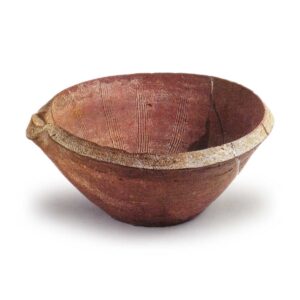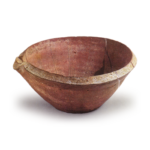
14th century
Height 13.0 cm, mouth diameter 29.5 cm, bottom diameter 14.0 cm
Suribachi, along with jars and pots, were the most common everyday utensils in the Middle Ages, and were produced in large quantities in all of Japan’s ceramic production areas. In Bizen as well, the Sue ware deep-bowl form was replaced by the Taiheibachi in the late Heian period. From the beginning, Bizen suribachi had a flat rim with the edge of the mouth cut off with a serrated edge, but the width of this flat rim expanded with the times. The use of a comb to grind grits into the inner surface also began in the middle of the Kamakura period (1185-1333). This mortar, dating from the end of the Kamakura period (1185-1333), has a wide mouth rim with a sharp cut with a pommel, and the one side of the mouth is widened as if to push it open, giving it a stately appearance. The inner surface of the bowl has six comb-shaped lines with a fairly wide space between them, and twelve lines are engraved radially. The firing is extremely solid, with a yellowish green natural glaze covering the edge of the mouth rim and part of the interior.








